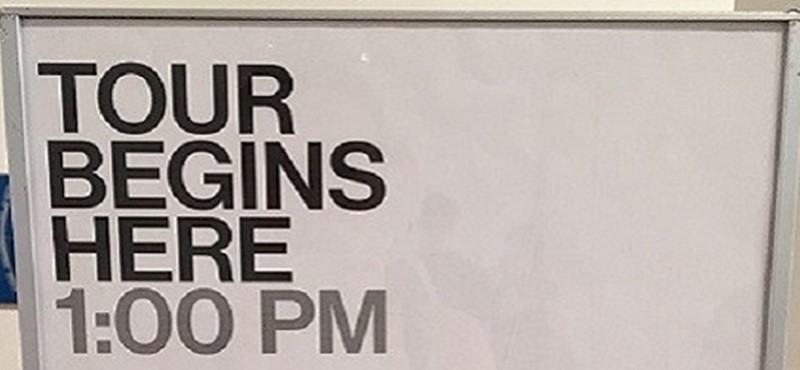Top tips for designing a touch tour

We live in a very visual world, and traditionally museum and gallery exhibitions are curated to engage people visually. We put fascinating artefacts in glass boxes and we position paintings at standing height eye-level with small interpretation panels beside them. The puzzle here then, is how do art enthusiasts and curious people who are visually impaired access the culture to be found in their public museums? And indeed in theatres, how do audience members grasp the layout and scale of the production before them? There is more to art than sight alone, and this is where touch tours can be one of the most inclusive events that your venue can organise. Here are some of our top tips for curating an invigorating touch tour:
1. Curate the perfect exhibition
What is the next exciting exhibition you’re going to unveil? Start thinking about accessible touch tours early on in the curation process so that you know what materials to search for. You’ll also give yourself plenty of time to think about creative ways to incorporate sensory features into your exhibition’s story, rather than simply having them as an add-on.
When thinking about artefacts to place before your audience, try to avoid simply choosing objects because they look like they might be interesting to touch. The materials and pieces of interpretation that you include in a touch tour should fit into the exhibition’s story as a whole. The Scottish Whisky Experience in Edinburgh have samples of peat for visitors to handle, and this is relevant to the story being curated on the wall panels and in the audio description. By engaging more than one sense in an exhibition, visitors are more likely to remember what they have experienced and learned.
There are different ways to incorporate touch into exhibitions, whether it be an isolated touch object in a gallery, a dedicated touch tour, or a handling session before a tour or performance. Think about which style is best suited to your current exhibition or event before embarking on design. Whichever you choose, be sure to include variety in the kinds of items visitors can feel. Three dimensional objects aren’t your only choice; consider also tactile line drawings to add interpretation to two dimensional paintings, Braille information panels, raised topographic maps, costumes and props; be creative!
2. Publicise your tour
It’s important to spread the word about your touch tour, or else nobody will know it exists! When you are publicising the exhibition itself, let your potential visitors know what dates and times the artefacts can be explored, and notify relevant groups or organisations about the event. You can add touch tour events easily to your Euan’s Guide listing and ask us to share them on our social media channels.
3. Distribute information beforehand
When people book your tour, email or send them information about the building they will be visiting and what to expect. Include information about meeting places, group size and the format of the tour. You could also send them an audio description of the museum, gallery or theatre where the event will be held, including an introduction to the exhibition itself. Always try to include large print and alternative formats of exhibition’s promotional leaflets or booklets and have these available at your information desk.
4. Be welcoming
Greet your tour group with a smile in your voice and always try to project clearly. It’s a good idea as with all tour groups to introduce your visitors to the building and to indicate where important amenities can be found.
5. Keep numbers small
Touch tours tend to move at a slower pace than visual tours, and this is because visitors will have to handle objects individually and need time to explore what they are feeling. It is therefore a good idea to hold regular tours but with smaller numbers. This way people will not get bored or impatient while waiting for everyone in a large crowd to engage with the object, and others will not feel rushed. While people are waiting their turn, continue to describe the object and its relevance as it is being passed amongst the group.
6. Be descriptive
Before you begin explaining, make sure you remember to describe! A touch tour guide is a vivid storyteller who must paint a visual image of touch objects for their audience. Talk about scale, patterns and materials; and as visitors are feeling the object, describe the specific parts they are touching.
7. …but don’t just describe the tour
On a moving tour it’s important to continue to engage visitors between stops. They’re not only interested in the exhibition they have come to explore, but most likely they are interested in the building they are in. Describe any important or unusual rooms you are passing; whether there is a particularly impressive view out of a large set of windows; where various doors lead to; and importantly, if you are passing any visitor toilets. Be sure to suggest breaks and stops when passing toilets so that nobody feels they are holding up the group if they wish to go.
8. Welcome any feedback
It’s good to adapt your tour based on the needs, requirements or suggestions of members of your group. Every group will be different, and each will present the opportunity to learn something new about touch tours and disabled access. You can use the introduction to ask individuals if they have any specific requirements to make the tour work for them. If people really enjoy themselves on your tour, encourage them to review it on Euan’s Guide! That way you will have great endorsements to publicise your exhibition even more.
Discover more Euan's Guide top tips >>


 Follow Euan's Guide on Instagram
Follow Euan's Guide on Instagram
 Follow Euan's Guide on LinkedIn
Follow Euan's Guide on LinkedIn
 Follow Euan's Guide on Facebook
Follow Euan's Guide on Facebook


Comments
You have to be signed in to leave a comment.
Login / Signup